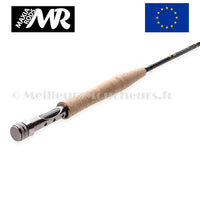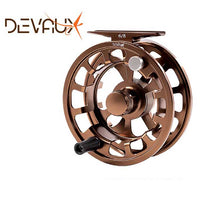big rivers
Domain of classic fly fishing, our most beautiful rivers are sometimes very impressive: great width and calm waters call for powerful but fine equipment allowing access to very beautiful fish.
Thin fast action rods allowing long distance casts, light reels balancing these rods well for total casting comfort with an effective drag, quality silks and long leaders and discreet tips are required.
What is a big river?
It is obviously difficult to classify the diversity of our rivers but let us try nevertheless to give some characteristics of what one can call a large river to release from it the material necessary to fish this type of environment.
A large river is already defined by the fact that it is difficult to reach it completely from one bank in fly fishing: the other bank remains more or less inaccessible. It is therefore generally necessary to fish in wading when entering the water. However, I do not put in this category the rivers (such as the Rhône) which are closer to fishing in a lake (from the shore or from a boat).
Moreover, in most cases, the depth can be significant and does not allow crossing: at a certain stage it is necessary to be able to fish precisely from a distance to reach the best positions, which not all fishermen will be able to covet...
The varied and powerful currents make it difficult to control the drift of the flies, suitable equipment and good technique are necessary.
The space available and the food which can be abundant, allow the development of good-sized fish: be careful to have powerful equipment to defeat your best catch!
The depth of the currents allows nymph fishing at different depths, which must therefore be reached.
Which rod to choose?
Here you have to be able to throw a little far. A medium power rod (#4 to #5) is therefore desirable for casting any type of fly and tackling somewhat difficult conditions (wind) with serenity. If you are a good caster, a fast action rod will make it easier for you to reach distant positions. It will also be more suitable if you fish a lot in nymph. You can nevertheless prefer a more moderate action rod and its pleasant casting even if it means not looking for the most distant fish: most of the catches are made at short to medium distance…. A rather long rod (9 feet to 9 feet 6) can simplify casting both by the acceleration it can give more easily to the line but also because if you are immersed in wading, its length can help you avoid to touch the water (or the ground). Given that you will be casting often and at great distance, a light rod will reduce your fatigue. For beautiful, difficult fish that will require you to fish very finely, a moderate action rod that is not too powerful will better protect your leader tip from breakage: grayling with a fast #6 rod and 10/100 n is not very easy...
Which reel is suitable?
You can be confronted here (and I hope you are!) with beautiful fish: a reel equipped with a drag of sufficient quality can prove to be useful. Knowing that you get out a lot of line with each cast, a quick recovery will allow you to fish more: a large harbor reel has its place or a semi-automatic reel like the well-known Vivarelli. A light reel will tire you less to cast it.
Which silk to choose?
A quality line, with good glide, will make casting easier. A casting profile such as Weight Forward (WF) is often recommended. Some will prefer a Double Tapper well adapted to the mending often necessary to avoid dragging or better a Triangle Tapper profile which combines the advantages of these two profiles.
Which leader to use?
The choice of leader can be very variable depending on the fishing techniques. However, large rivers allow the relatively easy use of large leaders (3.60m and more) to limit dredging problems in the currents and promote maximum discretion.
Other material
Do not forget a wading stick and be careful in deep water: always keep a margin to return safely to the bank.

























